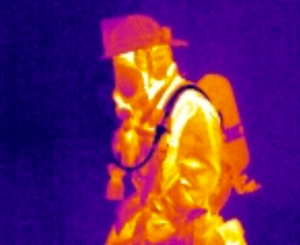 Ivy Tools was recently invited to take part in a firefighter training exercise in a nearby building set to be demolished. The local fire department was filling the empty building with non-toxic artificial smoke and sending in firefighters. We’re always up for an interesting thermal imaging application, so we grabbed a thermal camera and headed over to check it out.
Ivy Tools was recently invited to take part in a firefighter training exercise in a nearby building set to be demolished. The local fire department was filling the empty building with non-toxic artificial smoke and sending in firefighters. We’re always up for an interesting thermal imaging application, so we grabbed a thermal camera and headed over to check it out.
After a couple of preliminary explanations, we plunged right in. The fire department appointed one of their own to stay with us at all times for safety reasons. While the firefighters were suiting up for their drill, we “looked” around the smoky building. Now this is no news to firefighters, but a smoky building is highly disorienting. I had been in this building many times before, and as recently as a couple weeks prior. Yet I wasn’t six feet inside the door before I felt I had to stop and put out a hand so I didn’t run into anything. A few more steps and I wasn’t even sure where I was in the building. But wait…I have a thermal camera! While the dynamics of using a thermal imaging camera inside a burning building sometimes prove tricky, using one to image through fake smoke was a piece of cake. We explored the building a bit then established ourselves in a central open area where we could observe the drill.

Okay, the truth is that firefighting is pretty exciting work, even in a drill. The firefighting unit comes in wearing full gear: fire suit, helmets, oxygentanks, and face gear. Radio-filtered chatter and the raspy sound of breathing masks fills the building. They all carry axes, which look great in infrared. And every person on the team had a thermal imaging camera clipped to their chest. Yes, every firefighter was using thermal. They came in not standing up as I expected, but crawling. While all my firefighting experience (e.g. movies) had led me to believe that running was the preferred method of entering an engulfed building, crawling really makes better sense given how thick the smoke is. They went room by room checking for trapped occupants and keeping close tabs on one another. There are of course no real occupants in a training exercise, so the fire department uses heavy dummies with a heater inside to mimic the thermal pattern of a person. Not knowing where the dummies are placed, the firefighters work steadily and systematically to “clear the building”, then regroup and exit the structure.
The exercise left me with several impressions. First, firefighting really gets the blood pumping. It’s difficult yet exhilarating work. The firefighters emerged from the building drenched in sweat, but happy and talking of their work. Second, smoke deserves to be taken seriously. Even while I was under no real pressure to get out of the building, the disorienting effect of the fake smoke was rather troubling. Just as we all learned in school, the lesson here is to crawl and feel along the wall. Finally, it was great to see an entire unit of firefighters using thermal imaging cameras to keep themselves and possible occupants safe. They used the imagers to find their way in, clear the building, and exit safely. For confused occupants such as myself, these cameras are helping the heroes be even more heroic.
For more about how thermal cameras work, especially in non-fire building diagnostics, see our article on Thermal Camera Guide.